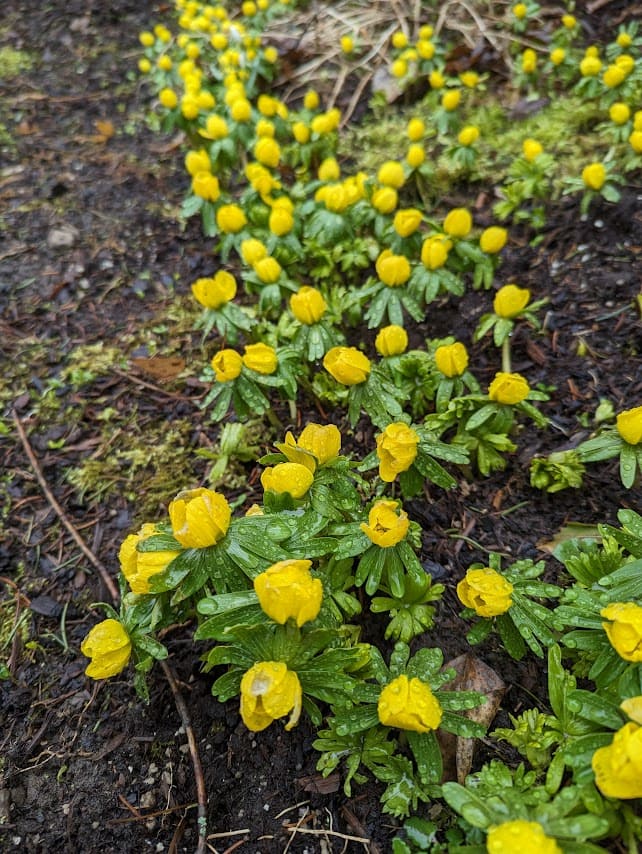We are one week into spring and we are already seeing things come into bloom.
No matter whether you thought this past winter was good or bad, those first signs of flowers in the garden are always a welcome sight. It gives us hope of warmer, sunnier days ahead.
Some of the first blooms in the garden (already out in full bloom) are our spring bulbs. Two of the earliest flowering bulbs are snowdrops and winter aconite.
These bulbs are ones you would purchase and plant in the fall, along with tulips and daffodils. Snowdrops (Galanthus nivalis) are the earliest to come into bloom, often poking their white, nodding, bell-shaped flowers up through the snow.
These bulbs are known for the way they naturalize themselves in the garden. Once you have planted them, there’s nothing more to do except enjoy the flowers year after year.
And the best part is every year they return, they get more and more flowers due to the new small bulbs that they produce. I like to refer to them as “free spirited.”
They can also be planted in lawn areas. Since they are so early to bloom, they will be finished flowering before the lawn needs to be cut and so the leaves can just be mowed down.
There are many varieties available, including both single and double flowering ones.
Winter aconite (Eranthus hyemalis) has bright golden/yellow, buttercup-like flowers that will cheer up any spring garden.
Do not dig up the plants when they are done blooming. Allow the foliage to die back naturally. If growing in the lawn, by the time your lawn is ready to mow, the leaves on the winter aconite will be withered and browned.
This tuberous bulb is stunning in borders, along walkways, in rock gardens and underplanting of shrubs and trees. It also looks great in a cottage-type garden.
Winter aconite is another plant that will naturalize given the right conditions. However, please note it is toxic when consumed by humans or animals.
One of the earliest perennials to bloom is the Lenten rose (Helleborus), aptly named as it is often in bloom during the season of Lent.
Although it is considered a perennial, it keeps its foliage during the winter months as well. As soon as the snow melts away, the Helleborus flowers start to emerge.
There are many different varieties available and its long-lasting flower colours include whites, pinks, reds, apple green to almost black.
Hellebores love a shadier, moist area and benefit from the addition of lime around their roots. They are hardy to zone 5.
Some flowering shrubs will start to bloom as soon as the signs of winter begin to melt away. One of the earliest shrubs to bloom is Chinese witch hazel (Hamamelis mollis).
A larger growing shrub, it can reach a height (and width) of 10 to 15 feet. It is known for its sweetly fragrant, golden yellow, unique shaped flowers. There is also a reddish/orange flowering variety of witch hazel named “Diane” (Hamamelis x intermedia ‘Diane’), one of which is blooming in front of the Niagara-on-the-Lake Community Centre now.
Witch hazel prefers a slightly sheltered location in full sun or a dappled shade. In fall, the leaves turn yellow to orange to red, making it showpiece in the garden. It is hardy to Zone 5.
Winter heath (Erica carnea) is another shrub that will provide you with flowers from late winter through mid-spring. This evergreen has masses of tiny flowers covering the entire plant.
There are many varieties, with flowers ranging from white to light pink to magenta and purple. Heath is a low-spreading evergreen growing about 18 inches high and two to three feet wide.
So if you cannot wait to get back out into the garden come spring and just yearn to see flowers opening up, you might want to consider adding some of these early bloomers to your landscape.
You will be welcoming spring into your homes that much sooner and who wouldn’t want that.
Joanne Young is a Niagara-on-the-Lake garden expert and coach. See her website at joanneyoung.ca.











